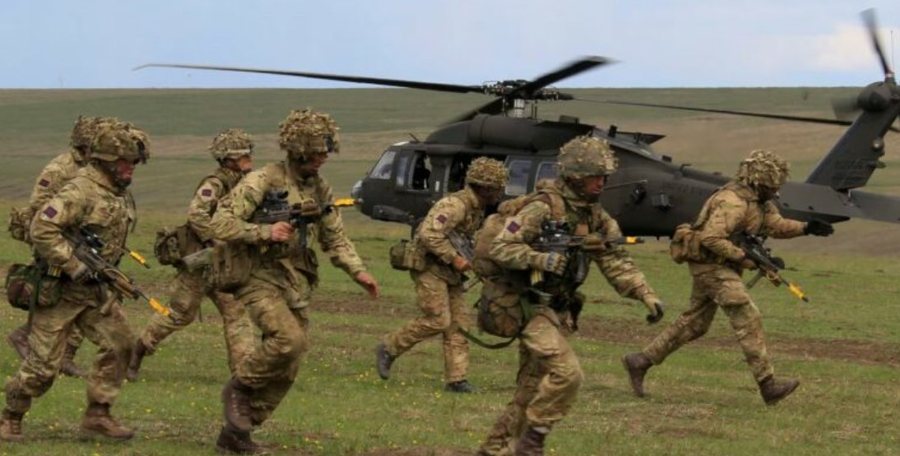
Just two weeks after a European Union summit where the bloc's leaders pledged to spend billions on defense at "a pivotal moment for Europe," they are returning to Brussels for another meeting on March 20-21.
This time, EU leaders aim to consolidate plans to strengthen Europe's defense autonomy amid doubts about American commitment to defending European states and continuing military support for Ukraine.
Ahead of the summit, the bloc's foreign ministers discussed on March 17 the latest proposal from EU foreign policy chief Kaja Kallas to find money for Kiev. And on March 19, the European Commission was scheduled to publish an action plan for the future of European defense.
The document is expected to come up with ideas on how to create the European Rearmament Plan, presented by the European Commission, through which the EU's executive arm will generate up to 800 billion euros in defense spending over the next four years.
As always, there are doubts in Brussels about how credible this is. Diplomats RFE/RL spoke to agreed that it was a good first step, but a senior EU official told RFE/RL that "the devil is always in the details, and there are many devils here."
Looking closer, it seems that the €800 billion figure is very ambitious, accompanied by major uncertainties: whether – and how quickly – this proposal could be translated into new weapons and ammunition; and whether any of those weapons would go to Ukraine.
The facts are clear. EU Defense Commissioner Andrius Kubilius told the European Parliament last week that Europe currently has a defense deficit of at least €500 billion and is also short “thousands of tanks and armored vehicles.”
EC President Ursula von der Leyen, also speaking in the EP, said that on average EU countries contribute just under 2 percent of GDP to defense. Washington is seeking to raise this to 5 percent, while NATO, according to sources within the alliance, is experimenting with the idea of making the official spending target 3.7 percent. This is expected to be said at the next NATO summit to be held in The Hague in June.
However, even if there is a large and rapid increase in defense spending, European diplomats say privately that it will take a decade for Europe to conduct any major military operations without U.S. assistance. In Europe, intelligence, surveillance, and research are currently provided by the United States.
Rearmament of Europe?
The Rearmament of Europe plan aims to address the EU’s dependence on the US by getting EU countries to increase their defence budgets. But will they do it? Of the €800 billion that Von der Leyen is aiming to generate, €650 billion could be raised by easing defence spending rules for EU member states over the next four years. The proposal would allow each member state to allocate an additional 1.5 percent of its gross domestic product to military spending. While this additional fiscal space is welcome, few believe that European capitals will make use of it.
The remaining €150 billion is a lending scheme provided by unused EU budget funds, which can be used by 20 countries in the bloc that do not have AAA credit ratings. The loans are intended to finance purchases from European defense manufacturers, but it remains unclear whether all components of the equipment must come from EU countries or whether they could come from non-EU countries such as Norway, Switzerland and Turkey.
The problem here is that this is still a loan, and many of the countries, especially those in Southern Europe, that need to increase defense spending are already deep in debt.
Also, some Northern European countries are questioning the logic of this proposal, with the Dutch Parliament recently passing a non-binding resolution to reject the plan for the Rearmament of Europe, arguing that it only plunges the European bloc further into debt.
Then there is the third part of Von der Leyen’s proposal, which would allow member states to use over €300 billion of remaining funds in the EU budget for defense, which would normally go to the bloc’s poorest regions for infrastructure investment. The problem here, again, is that this is voluntary. This means that while it cannot be blocked by friendly countries like Hungary and Slovakia, as it does not require unanimity, some states will not bother unless they are forced to.
Germany
Then there's Germany. The incoming chancellor, Friedrich Merz, has promised huge defense spending. On March 18, German lawmakers voted for a huge increase in defense spending. The law passed by the Bundestag would allow defense spending to exceed Germany's strict debt rules to create a 500 billion euro fund for defense infrastructure.
"This step we are taking today on defense readiness... is just the first big step towards the new European defense community," Merz said.
On Friday, the law will move to the upper house of parliament for approval.
Von der Leyen described German lawmakers' decision to allow for greater defense spending as "great news."
"It sends a clear message to Europe that Germany is determined to invest massively in defense," she said.
Until now, the laws stipulated that the budget deficit limit of 0.35 percent of Gross Domestic Product could not be exceeded, except in emergency cases.
Germany's move could potentially reignite calls from southern European countries for Brussels to issue eurobonds for defense investment. The same thing happened to combat the recession that gripped the continent after the coronavirus pandemic. Issuing joint eurobonds is opposed by most northern European countries, particularly the Netherlands and Germany – but with Berlin making it clear that defense spending is a must – the proposal could pass.
Military mobility and the Danish model
Eurobonds, or “defense bonds,” are likely to be included in the European Commission’s action plan for the future of European defense. But what’s really interesting and worth following up on are some proposals on military mobility. It may not seem like the most urgent thing, but EU officials are already seeing how important it is to be able to move military equipment quickly from one EU member state to another.
As things stand now, this would not be easy. There are no harmonised rules across the bloc, for example, for moving military equipment from one EU country to another in the event of an emergency. Initiatives such as strengthening bridges, railways and roads to enable the transport of heavy military equipment are also suggested in the action plan.
Another aspect that is likely to be included is the idea of integrating Ukraine’s defense market into the EU market, as the country moves slowly but surely towards membership in the bloc. This is seen by many European diplomats as a real victory for the EU, as Ukraine now has perhaps the most capable military on the continent and is “ahead of everyone in aspects such as military drones,” as an EU official with knowledge of the matter told REL.
In this context, the document will also promote the so-called Danish model of support for Ukraine. This approach involves EU member states directly providing Ukrainian-made defense equipment or establishing partnerships with Ukrainian defense companies. The idea of training Ukrainian soldiers in Ukraine, and not only in the EU, is also mentioned.
Ukraine aid
But these plans are all for the future, and the question remains what Brussels can do for Ukraine now. Kiev has hinted that it may need up to 33 billion euros in additional military support this year. With the United States unlikely to contribute much, the EU needs to find most of that urgently.
EU foreign policy chief Kaja Kallas last week presented a new plan for the bloc’s member states. The plan, seen by REL, proposes voluntary schemes that encourage countries to participate “to provide military assistance to Ukraine by 2025, with a provisional value of at least 20 billion euros and possibly reaching up to 40 billion euros depending on Ukraine’s needs.”
The text gives a deadline of April 30 for those participating to declare how they plan to meet their respective contributions and says that payments must be committed no later than June 30 to ensure deliveries by the end of this year.
The plan says the money should go mainly for large-caliber artillery ammunition, air defense systems, missiles, drones, fighter jets and training of Ukrainian troops. It should also support other contributions from member states, for example, sending troops to Ukraine in the event of a peace deal.
The plan still suggests that countries should contribute in line with their economic weight, based on gross national income. The idea had previously angered France, which claims that proponents of military support for Ukraine, such as the Kiel Institute for the World Economy, are wrong and that Paris does a lot in secret and is also willing to send soldiers to Ukraine to protect a possible future ceasefire. /rel/ (A2 Televizion)










